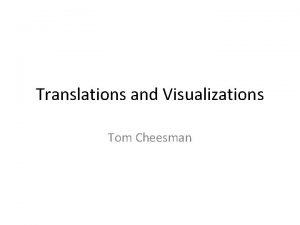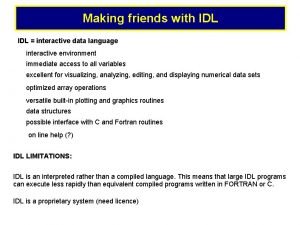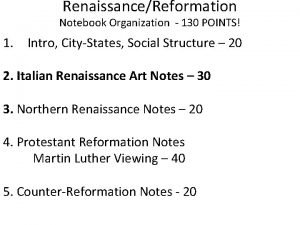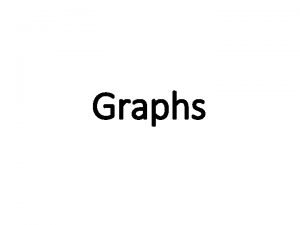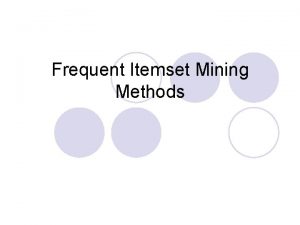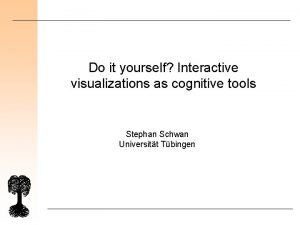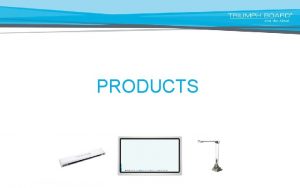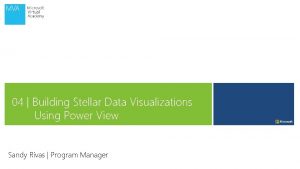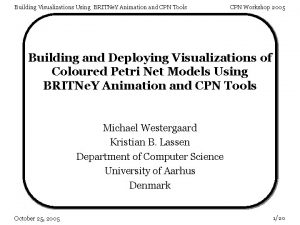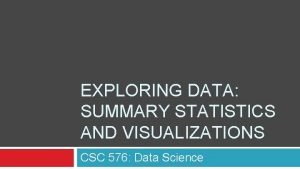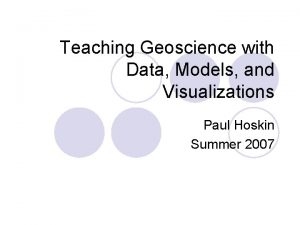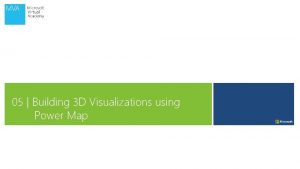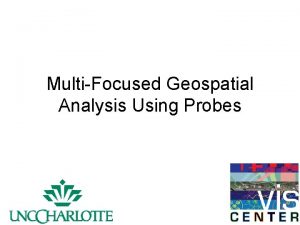Interactive Data Visualizations using R and ggvis 6
























- Slides: 24

Interactive Data Visualizations using R and ggvis 6 April 2018 Mc. Gill Library Research Commons Presented by Zia D. and Mike G.

Outline ● Loading data into RStudio ● Introduction and basics of ggvis ● Lines & Syntax ● Interactivity and Layers ● Customizing Axes, Legends, Scales ● Mapping

Required R Libraries > install. packages("ggvis") > library(ggvis) > library(dplyr)

Loading your data set #set working directory > setwd(“c: /r_data”) #verify working directory > getwd() #load the. csv into a variable named hospital_data > hospital_data <- read. csv(“quebec_hospital_data_subset. csv”) #if problems loading CSV hospital_data <- read. csv(“quebec_hospital_data_subset. csv”, file. Encoding="latin 1")

Verify that the data has loaded correctly #view data headers > names(hospital_data) ● This should reproduce the following:

Convert textual data to numeric This code converts the data in each column from textual to numeric #as. numeric for columns 1, 6, 7, 8 > hospital_data[, 1] <- as. numeric(hospital_data[, 1]) > hospital_data[, 6] <- as. numeric(hospital_data[, 6]) > hospital_data[, 7] <- as. numeric(hospital_data[, 7]) > hospital_data[, 8] <- as. numeric(hospital_data[, 8])

Grammar of Graphics ● Underlying structure of ggvis Data + Coordinate System + Marks + Properties

Basics #formula <data> %>% ggvis(~x, ~y, properties) %>% layer_<marks>(properties) #pipe operator (from library dpylr) %>%

Lines & Syntax #graph hospitals against proportion of series as a scatterplot > hospital_data %>% ggvis(~Proportion, ~Installation) %>% layer_points() #change mark layer_lines() layer_bars() layer_ribbons() layer_smooths()

Visual Properties #change properties >hospital_data %>% ggvis(~Proportion, ~Installation, fill : = “blue”, size : = 100, shape : = “square”) %>% layer_points() >hospital_data %>% ggvis(~Proportion, ~Installation) %>% layer_points(fill : = “red”, size : = 50, shape : = “diamond”) #some other properties: stroke, stroke. Width, opacity, fill. Opacity, stroke. Opacity, fill. hover

Visual Properties #map property to a variable >hospital_data %>% ggvis(~Proportion, ~Installation, fill = ~Région) %>% layer_points() >hospital_data %>% ggvis(~Proportion, ~Installation) %>% layer_points(fill = ~Région)

Interactivity #adding sliders >hospital_data %>% ggvis(~Proportion, ~Installation, size : = input_slider(10, 100), opacity : = input_slider(0, 1)) %>% layer_points()

Layers ● Two layer types: simple and compound ● Simple represent basic geometric shapes like lines, points and triangles ● Compound represent data transformations along with one or more simple layers

Simple layer #scatter plot > hospital_data %>% ggvis(~Proportion, ~Installation, stroke = “red”) %>% layer_points()

Compound layers ● layer_lines() - order by the x variable ● layer_smooths() - fits a smooth model to the data, and displays predictions in a line

Layer_smooths example #highlights the trend in noisy data > hospital_data %>% ggvis(~Région, ~Nombre. de. visites. totales) %>% layer_smooths() #interactive version > span <- input_slider(1, 5, value=1) hospital_data %>% ggvis(~Région, ~Nombre. de. visites. totales) %>% layer_smooths(span = span)

Customizing axes #create a simple scatter plot and rename x-axis >hospital_data %>% ggvis(~Installation, ~Proportion) %>% layer_points() %>% add_axis("x", title = "Hospital names")

Other axis options > add_axis("x", title = "Hospital Names", ticks = 40, properties = axis_props(ticks = list(stroke = "red"), major. Ticks = list(stroke. Width = 2), grid = list(stroke = "red"), labels = list(fill = "steelblue", angle = 50, font. Size = 14, align = "left"), title = list(font. Size = 16))) > add_axis “x”, title = “Title Name”, title_offset = 50

Customizing legends #add_legend > add_legend(vis, scales = NULL, orient = "right", title = NULL, format = NULL, values = NULL, properties = NULL) hide_legend(vis, scales) #legend_props > legend_props(title = NULL, labels = NULL, symbols = NULL, gradient = NULL, legend = NULL)

add_legend examples #add_legend one variable > hospital_data %>% + ggvis(~Nombre. de. visites. totales, ~Proportion, fill = ~Installation) %>% + layer_points() %>% + add_legend("fill", title="Custom name") #add_legend two variables >hospital_data %>% + ggvis(~Nombre. de. visites. totales, ~Proportion, fill = ~Installation, size = “Nombre. de. visites. P 4. et. P 5) %>% + layer_points() %>% + add_legend(c( "fill", "size"))

Further legend customization >hospital_data %>% + ggvis(~Nombre. de. visites. totales, ~Proportion, fill = ~Installation) %>% + layer_points() %>% + add_legend("fill", title = "Cylinders", properties = legend_props(title = list(font. Size = 16), labels = list(font. Size = 12, fill = "#00 F"), gradient = list(stroke = "red", stroke. Width = 2), legend = list(x = 500, y = 50)))

Mapping data - Quebec Admin Boundaries Shapefile Libraries: rgdal, rgeos > montreal_map <- read. OGR("c: /r_data", "District. Elect") > montreal_wgs 84 <- sp. Transform(montreal_map, CRS ("+proj=longlat +datum=WGS 84")) > plot(montreal_wgs 84, axes=TRUE)

Plot data onto shapefile >plot(montreal_wgs 84) >points(hospital_data$Longitude, hospital_data$Latitude, col="blue", pch=19)

Further documentation ● RStudio ggvis 0. 4 overview ● CPAN documentation
 Ggvis in r
Ggvis in r Delighted visualizations
Delighted visualizations Idl interactive data language
Idl interactive data language Sharing of diverse information through universal web access
Sharing of diverse information through universal web access Interactive data walls
Interactive data walls System.collections.generics
System.collections.generics Defrost using internal heat is accomplished using
Defrost using internal heat is accomplished using Using big data to solve economic and social problems
Using big data to solve economic and social problems Linear communication model
Linear communication model Steiner model of group effectiveness
Steiner model of group effectiveness Vbo1
Vbo1 The big 4 and the treaty of versailles interactive notebook
The big 4 and the treaty of versailles interactive notebook Renaissance and reformation interactive notebook
Renaissance and reformation interactive notebook Top down process of reading
Top down process of reading Managing personal communication
Managing personal communication Physical and chemical properties interactive
Physical and chemical properties interactive Advantages of aristotle model of communication
Advantages of aristotle model of communication Weather and climate interactive activities
Weather and climate interactive activities Examples of written language
Examples of written language Interactive processing
Interactive processing Interactive guide to healthy eating and active living
Interactive guide to healthy eating and active living Sequential data structure example
Sequential data structure example Using stolen data
Using stolen data A graphical display of data using bars of different heights
A graphical display of data using bars of different heights Mining frequent itemsets using vertical data format
Mining frequent itemsets using vertical data format

